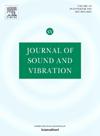Assessing the quality of the time delay estimate in acoustic leak localisation
IF 4.3
2区 工程技术
Q1 ACOUSTICS
引用次数: 0
Abstract
The problem considered in this paper is assessing the quality of the time delay estimate between leak signals measured on water pipes. This is practically important, as a quantitative assessment of the accuracy of time delay estimation (TDE) results makes it possible to infer the reliability of acoustic leak localisation results in a given situation. Three quality assessment approaches are developed by considering the statistical properties of the cross-correlation function (CCF): information-criterion, processing gain, and statistical approaches. In the information-criterion approach, the Bayes factor (BF) is employed to decide the most likely probability distribution of observed CCF peak values. The processing gain approach determines the quality of the time delay estimate using indices that indicate detectability of the CCF peak, namely, the peak-to-side lobe ratio (PSR) and the peak-to-mean ratio (PMR). In the statistical approach, an index termed inconsistency score (ICS) is used to describe the quality of TDE results based on root-mean square of deviations of time delay estimates from their statistical mode. Experimental results show that the proposed approaches provide effective means of assessing the accuracy of the time delay estimate in acoustic leak detection applications. Also, the proposed indices can be employed as figures of merit for selecting best parameters for TDE, for example, filter cut-off frequencies.
评估声学泄漏定位中时间延迟估计的质量
本文考虑的问题是评估在水管上测量到的泄漏信号之间的时延估计质量。这一点具有重要的实际意义,因为通过对时延估计(TDE)结果的准确性进行定量评估,可以推断出在特定情况下声学泄漏定位结果的可靠性。通过考虑交叉相关函数 (CCF) 的统计特性,开发了三种质量评估方法:信息标准、处理增益和统计方法。在信息标准方法中,贝叶斯因子(BF)被用来决定观测到的 CCF 峰值最可能的概率分布。处理增益法使用表示 CCF 峰值可探测性的指数(即峰值与侧叶比率 (PSR) 和峰值与平均值比率 (PMR))来确定时延估计的质量。在统计方法中,一种称为不一致性得分(ICS)的指数被用来描述基于时间延迟估计值偏离其统计模式的均方根的 TDE 结果质量。实验结果表明,在声学泄漏检测应用中,所提出的方法为评估时延估计的准确性提供了有效手段。此外,所提出的指数还可用作选择 TDE 最佳参数(如滤波器截止频率)的优点指数。
本文章由计算机程序翻译,如有差异,请以英文原文为准。
求助全文
约1分钟内获得全文
求助全文
来源期刊

Journal of Sound and Vibration
工程技术-工程:机械
CiteScore
9.10
自引率
10.60%
发文量
551
审稿时长
69 days
期刊介绍:
The Journal of Sound and Vibration (JSV) is an independent journal devoted to the prompt publication of original papers, both theoretical and experimental, that provide new information on any aspect of sound or vibration. There is an emphasis on fundamental work that has potential for practical application.
JSV was founded and operates on the premise that the subject of sound and vibration requires a journal that publishes papers of a high technical standard across the various subdisciplines, thus facilitating awareness of techniques and discoveries in one area that may be applicable in others.
 求助内容:
求助内容: 应助结果提醒方式:
应助结果提醒方式:


